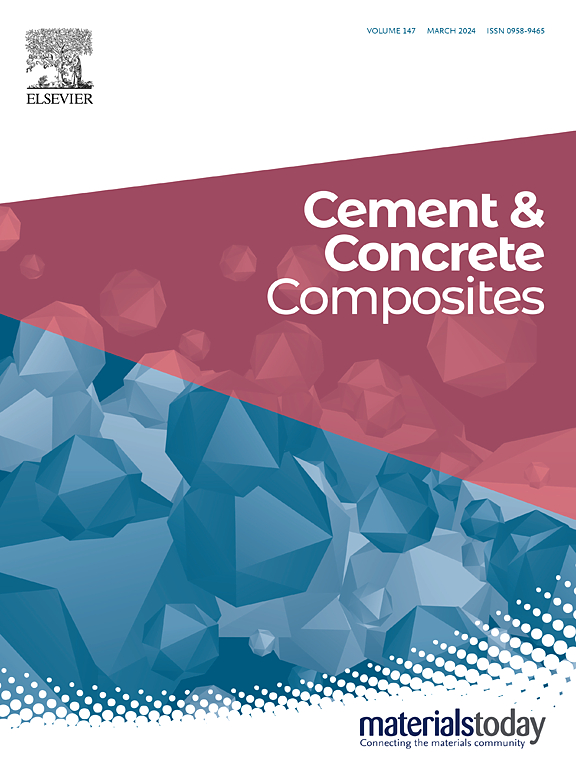基于深度学习和多维表征的水泥基材料裂纹自愈性能评价
IF 13.1
1区 工程技术
Q1 CONSTRUCTION & BUILDING TECHNOLOGY
引用次数: 0
摘要
裂缝是水泥基材料的一个长期存在的问题,特别是在腐蚀性环境中,如海洋条件下,侵略性离子会加剧这个问题。为了应对这一挑战,研究人员提出了一种新的自我修复方法,该方法将层状双氢氧化物(LDHs)与微生物矿化相结合,并对其有效性进行了全面评估。以钙基、铝基无机矿物为核心,结合微生物孢子,研制了一种新型核壳愈合剂。引入深度学习的概念定量评估治疗效果。采用密集残差网络(DRN)和多维裂纹评价方法对裂纹修复效果进行量化,结果表明,经过一定的养护期后,各性能指标均有较大改善。此外,对各种裂纹表征方法的原理进行了分析和分类。结果表明,这些方法可能反映了表面修复效果,内部修复效果,或两者的结合。此外,对修复产物进行了显微分析,以确定其组成、形态、元素分布和孔径分布。自愈机制为自愈剂原位形成LDH,在固定氯离子、硫酸盐离子和水分子的同时膨胀填充裂缝,从而减轻侵蚀离子的损伤。LDH的形成也消耗了大量的氢氧化物离子,将溶液转化为有利于微生物生长和矿化的轻度碱性环境,进一步增强和巩固愈合效果。该研究为腐蚀环境下裂纹修复和裂纹愈合性能的多维表征提供了科学依据。本文章由计算机程序翻译,如有差异,请以英文原文为准。
Evaluation of crack self-healing performance in cement-based materials using deep learning and multidimensional characterization
Cracks are a persistent issue in cement-based materials, especially in corrosive environments, such as marine conditions, where aggressive ions exacerbate the problem. To address this challenge, a novel self-healing method, which combines layered double hydroxides (LDHs) with microbial mineralization, has been proposed, with its effectiveness comprehensively evaluated. A new core-shell healing agent was developed, incorporating calcium-based and aluminum-based inorganic minerals as the core along with microbial spores. The concept of deep learning was introduced to quantitatively assess the healing performance. A dense residual network (DRN) and a multidimensional crack evaluation method were applied to quantify the crack repair effects, revealing considerable improvements in all performance indices after a certain curing period. In addition, the principles of various crack characterization methods were analyzed and classified. Results indicate that these methods may reflect the surface repair effects, internal repair effects, or a combination of both. Furthermore, repair products were microscopically analyzed to identify their composition, morphology, elemental distribution, and pore size distribution. The self-healing mechanism was elucidated as the in situ LDH formation from the healing agents, which expanded to fill the cracks while immobilizing chloride ions, sulfate ions, and water molecules, thereby mitigating the damage from aggressive ions. The LDH formation also consumed a substantial amount of hydroxide ions, converting the solution into a mildly alkaline environment that favored microbial growth and mineralization, further enhancing and consolidating the healing effect. This study provides a scientific basis for crack repair in corrosive environments and for the multidimensional characterization of crack healing performance.
求助全文
通过发布文献求助,成功后即可免费获取论文全文。
去求助
来源期刊

Cement & concrete composites
工程技术-材料科学:复合
CiteScore
18.70
自引率
11.40%
发文量
459
审稿时长
65 days
期刊介绍:
Cement & concrete composites focuses on advancements in cement-concrete composite technology and the production, use, and performance of cement-based construction materials. It covers a wide range of materials, including fiber-reinforced composites, polymer composites, ferrocement, and those incorporating special aggregates or waste materials. Major themes include microstructure, material properties, testing, durability, mechanics, modeling, design, fabrication, and practical applications. The journal welcomes papers on structural behavior, field studies, repair and maintenance, serviceability, and sustainability. It aims to enhance understanding, provide a platform for unconventional materials, promote low-cost energy-saving materials, and bridge the gap between materials science, engineering, and construction. Special issues on emerging topics are also published to encourage collaboration between materials scientists, engineers, designers, and fabricators.
 求助内容:
求助内容: 应助结果提醒方式:
应助结果提醒方式:


